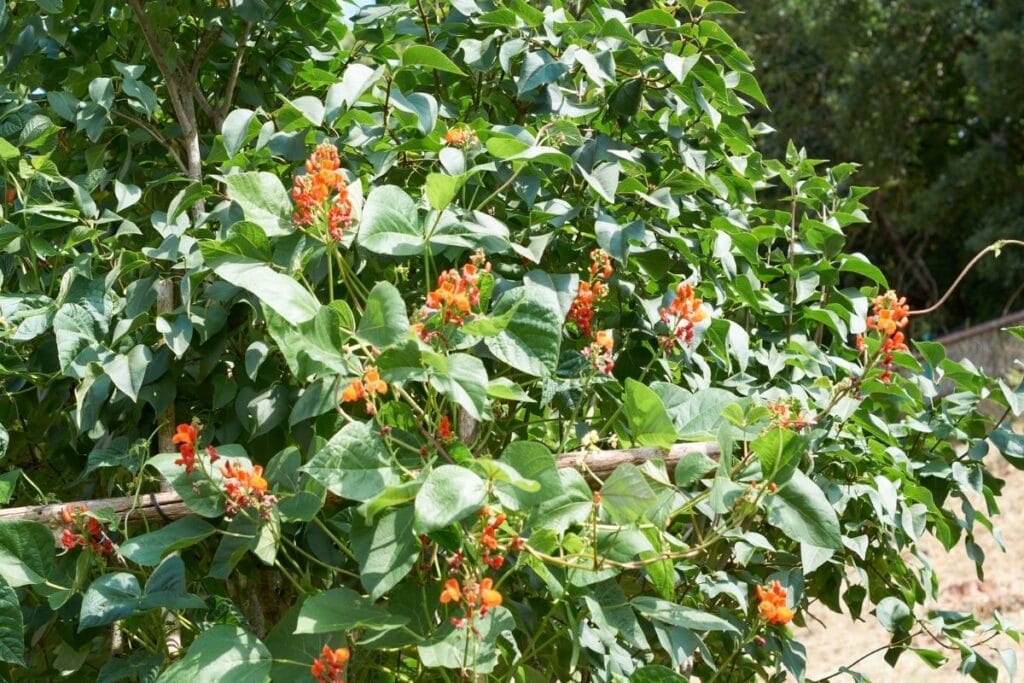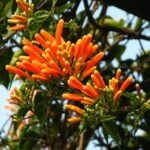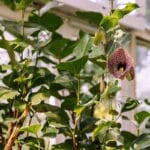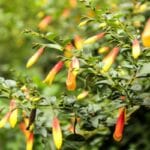The scarlet runner bean vine is a close relative of the common bean, Phaseolus vulgaris, therefore the resemblance. However, the former is less known and underutilized than the latter, despite giving almost the same benefits.
The scarlet runner bean ticks three boxes – functional, aesthetically pleasing, and edible. These characteristics make it an ideal flowering vine to be added to edible landscape designs and any other landscapes.
Botanical Information
The perennial vine, scarlet runner bean, is scientifically referred to as Phaseolus coccineus, and that it belongs under the Fabaceae family. The species of this vine, coccineus, is Latin that translates to red or scarlet referring to its flowers.
Moreover, this vine is commonly referred to as multiflora bean, runner bean, scarlet runners, red giant, scarlet emperor, scarlet runner beans, scarlet conqueror, scarlet kidney bean, butter bean, fire bean, and White Dutch runner.
The presence of numerous common names is one of the products of this vine being naturalized and domesticated in various areas.
Spatial Distribution
Scarlet runner beans (Phaseolus coccineus) are native to Central America, South America, and Mexico. They have been cultivated in different countries to optimize their edible parts and nitrogen-fixation abilities. Scarlet runner beans are hardy in USDA hardiness zones 7 to 11.
Growth Habits
As a robustly growing vine, it extends from 2 to 5 feet wide and up to 15 feet in height. Although, the vine’s height will be determined by the existence of supporting structures where the vine twists in a clockwise direction.
When the vine is established, it will start to produce showy flowers which happen around June to October or during the growing season. Also, the Scarlet Runner tends to be a perennial in places where frost does not occur.
However, the vine tends to die down and be an annual plant under extremely cold conditions when planted in areas with frost. Along with this vine’s effortless growth are colorful flowers, pods, and seeds that give color wherever it is planted.
Leaves
The scarlet runner vine gives rise to deep green, broad, and elliptic leaflets in clusters of three or trifoliate. These leaflets extend from 3 to 5 inches in length and have a distinct underside having purple veins.
Flowers
As one of the main attractions for this vine, the famous scarlet flowers extend from 1 to 2 inches long. What makes it more eye-catching is that these orange flowers are bunched together in sets of 20.
This characteristic aids the self-pollination process by enticing pollinators such as hummingbirds and bees. Edible flowers can be added to salads and have a taste similar to beans.
Fruit and Seeds
Aside from the flowers, this vine is also planted for its pods and seeds. The scarlet runner bean produces light green pods with a slightly rough texture that may extend up to 1 foot long. ON the other hand, the seeds are uniquely colored and have different color combinations.
Some seeds are black with red splats, dark violet with deep terracotta mottles, violet with black patches, or white. When cooking the seeds, they turn gray and make it unappetizing for some.

Grow and Care Tips
Sun
Scarlet Runner Beans thrive in full sun. Grow scarlet runner beans in a location that receives at least 6–8 hours of direct sunlight daily. Adequate sunlight is essential for robust growth, flowering, and the development of both foliage and beans.
Choose a sunny spot in your garden or on your balcony for optimal results.
Water
Consistent moisture is key for optimal growth and bean production. Aim to water your Scarlet runner bean vines deeply 1-2 times per week, depending on your climate and rainfall.
Avoid overwatering, as soggy soil can cause root rot. During hot and dry periods, increase watering frequency to ensure the soil remains evenly moist but not waterlogged.
Temperature and Humidity
Scarlet runner beans thrive in warm weather, with ideal temperatures ranging from 65°F to 85°F (18°C to 29°C). They are relatively tolerant of cool temperatures and can withstand light frosts.
However, excessively hot weather can hinder flowering and pod set. Moderate humidity levels are preferred, as high humidity can encourage fungal diseases. Scarlet runner beans can be grown in mild climates with a long growing season.
Soil
In terms of the growing media, the vine thrives in damp, fertile, rich in organic matter, and has good drainage. While most soil types, from sandy to loamy and clay, can work as long as they meet these key characteristics, it’s crucial to pay attention to soil temperature. Aim for a warm soil temperature between 65°F and 85°F (18°C and 29°C) at planting time.
Moreover, this vine grows best in soil pH levels that are more neutral and basic.
Fertilizer
While runner beans fix their own nitrogen from the air, they still benefit from supplemental fertilization. Apply a balanced organic fertilizer at planting time and again mid-season to encourage healthy growth and bountiful yields.
Avoid over-fertilizing, as excess nitrogen can promote leafy growth at the expense of bean production.
Maintenance Activities
Regular light pruning and removal of damaged and dry plant parts are one of the few maintenance activities to be done. Also, regularly checking the stability of the vine’s supporting structures should be performed, as it may affect the growth of the vine.
A non-compulsory activity, such as removing young pods, may be enforced to favor the growth of new flowers rather than the production of pods. This activity will depend on the grower’s preference.
Propagation
There are two common plant materials used to grow scarlet runner bean vine – seeds and tuberous roots. However, the growing media, location, and time of planting should be planned before harvesting the said materials.
Use a media that has a good water holding capacity and porous enough to provide good drainage. It should also be rich in nutrients. Choose a spot where full sunlight is available and time the planting during spring.
When seeds are used for propagation, the planting distance should be 4 to 6 inches and buried 2 to 3 inches below ground. Cover the seed with slightly loose soil. Germination is expected 7 to 14 days after sowing, while flowering is at 28 to 35 days after sowing. Moreover, the initial harvest may be done 60 to 75 days after sowing.
On the other hand, the tuberous roots of the Scarlet Runner can be used by separating them carefully. Using moist sand as a growing medium and keeping it in a cool place will favor the plant regrowth.
Common Pests and Diseases
Keep an eye out for common pests such as aphids and spider mites. Regularly inspect the undersides of leaves and use insecticidal soap or neem oil for control.
Additionally, good air circulation helps prevent fungal diseases. If signs of diseases like powdery mildew appear, treat with appropriate fungicides following the recommended guidelines.
Common Cultivars of Scarlet Runner Bean Plants
‘Golden Sunshine’
This cultivar stands out by having faint yellow-green leaves.
‘Sunset’
The Sunset cultivar showcases clusters of beautiful pink flowers.
‘Moonlight’
Having white flowers and the absence of strings on its pods is what this cultivar is known for.
‘Painted Lady’
This cultivar produces two-colored flowers with a mixture of pink and red. Although, sometimes it also bears white flowers. Furthermore, its beans are dirty white with thin dark brown strips.
‘White Dutch Runner’
This cultivar adds white color to the landscape with its flowers and beans.
‘Black Runner’
The identifying characteristics of this cultivar are its saturated rouge flowers and black beans.
‘Scarlet Runner’
This cultivar is identified by deep reddish-brown beans with black speckles.
‘Scarlet Emperor’
This cultivar yields more elongated and heavier pods with purple and black speckled beans.
‘Butler’
This cultivar has fewer strings on its pods.
‘Polestar’
The Polestar cultivar grows a pod with no strings that elongate up to 12 inches. However, it is optimal to harvest at 6 to 8 inches in length.
Uses of Runner Beans
Scarlet runner beans are a versatile plant that can be used for both ornamental value and culinary purposes. They require proper support such as stakes, trellises, or tripods. The vine is known to attract hummingbirds, butterflies, bees, and other wildlife, making it a great addition to any garden.
The red flowers of runner beans can be used in salads or as garnishes, while immature pods can be steamed and seasoned to taste. It is best to use open flowers right away.
Immature seeds can be cooked using the same recipe as lima beans, while mature seeds are left inside the pod to dry for a longer shelf life and to preserve protein content.
Lastly, the roots are often boiled, soaked, or peeled before cooking to lessen the possibility of toxicity.
Potential Harm
Ingesting mature seeds and tubers fresh from a harvest without cooking may cause gastric problems. A lectin, phytohaemagglutinin, shows some amount in the said plant parts wherein if ingested numerous amounts may induce diarrhea and other stomach issues.
FAQs
Is Scarlet Runner a pole bean?
Yes, Scarlet Runner beans (Phaseolus coccineus) are a variety of pole bean. They produce long vines and are often grown vertically on poles or trellises.
Is it OK to eat scarlet runner beans?
Yes, while the mature seeds of Scarlet Runner beans are typically used for decoration rather than consumption due to their tough texture, the young pods and flowers are edible. Harvest them when they are young and tender for the best eating quality.
What are scarlet runner beans similar to?
Scarlet Runner beans are similar to other types of runner beans and certain varieties of pole beans. They are also related to common green beans (Phaseolus vulgaris), but the flavor and texture may differ slightly.
Why can’t you eat scarlet runner beans raw?
Scarlet runner beans should not be eaten raw because they contain toxic compounds like lectins and protease inhibitors. Cooking them thoroughly is necessary to make them safe for consumption.
For more vines to grow, see our list of different vines.
References
*image by walldi/depositphotos






